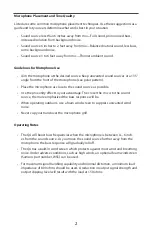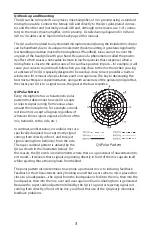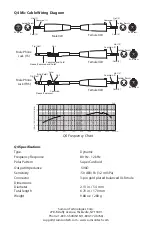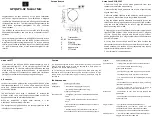
2
Microphone Placement and Tone Quality
Listed are some common microphone placement techniques. Use these suggestions as a
guide and let your ears determine what works best in your situation.
• Sound source less than 6 inches away from mic—Full sound, pronounced bass,
increased isolation from background noise.
• Sound source 6 inches to 2 feet away from mic—Balanced natural sound, less bass,
some background noise.
• Sound source 3 to 6 feet away from mic—Thinner ambient sound.
Guidelines for Microphone Use
• Aim the microphone at the desired source. Keep unwanted sound sources at a 135°
angle from the front of the microphone (see polar pattern).
• Place the microphone as close to the sound source as possible.
• Use the proximity effect to your advantage: The closer the mic is to the sound
source, the more emphasized the bass response will be.
• When operating outdoors, use a foam windscreen to suppress unwanted wind
noise.
• Never cup your hand over the microphone grill.
Operating Notes
• The Q4 will boost bass frequencies when the microphone is between 0—6 inch-
es from the sound source. As you move the sound source further away from the
microphone, the bass response will gradually roll off.
• The Q4 has a built-in wind screen which protects against most wind and breathing
noise. Under adverse conditions, such as high winds, an optional foam windscreen
(Samson part number, WS5) can be used.
• For maximum signal handling capability and minimal distortion, a minimum load
impedance of 800 ohms should be used. A reduction in output signal strength and
output clipping level will result with the load at 150 ohms.






















